|
| ||
|
(Sight Lines) An often overlooked aspect of track making are sight lines. What are sight lines? Sight lines are the visual cues we provide racers so they know where the course is leading them. On a track like Crazy98, and others like it, this isn't really an issue because the road is clearly visible directly in front of you at all times. However, this is not always the case with many custom tracks. For the purpose of demonstrating good examples of sight line strategies, we'll look at Bobsled Rally Way by Spider, Snowbound TOC edition by Skyman, and Lakebed Extreme by GTX_Valvejob. Bobsled Rally WayThe first location we're interested in is the mid-race convergence of railway and roadway. The textures are a multitude of color and the correct path is by no means obvious. 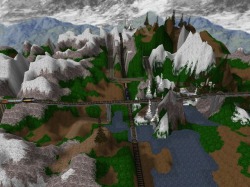 As you come up the hill toward the intersection, the surrounding terrain and direction of the road suggest the course should go straight. 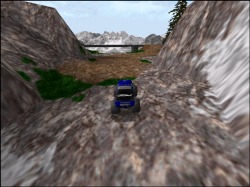 It is therefore very easy to imagine yourself going straight, and finding yourself on the wrong road, probably crashed, and out of the race. To help racers, Spider provides two visual cues. The first is the tree on the right; the second is the dirt texture leading right. After a few practice laps, the racer learns these visuals are unique to this location and are an aid in determining the correct driving line to follow. 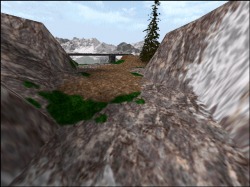 This intersection would be particularly devastating were it not for the visual references provided by the maker. For instance, moving forward just a couple hundred feet (in the correct direction), we are immediately confronted by yet another directional problem.  Following this jump is a huge drop down to a large lake surrounded by some pretty rugged terrain. The approach gives no indication of what's to come, and a minor slip will put you on the roof with the potential of even losing your way. A good landing is crucial to a good lap. To assist in this task, Spider has planted two snow-capped, very tall trees that mark the landing area edges. The tips of these trees are visible from the approach to the jump and despite the obscurity of the drop, they very clearly mark where a racer wants to go in much the same way as the sights on a rifle show the marksman the trajectory of a bullet. In this way, a racer is able to 'thread the needle' so to speak.  It is easy to take such markings for granted, but you better believe each and every visual cue has been inserted with an eye to providing clear sight lines. There is no coincidence or accident here. Everything has been done deliberately. A second example of the 'gun sight' strategy is found here. A road that approaches a blind spot straight on, and continues straight after the leap doesn't need obvious markers such as these. But when the jumps and blind spots occur in the middle of a bend, the markers can be the difference between a successful lap, or a crash. 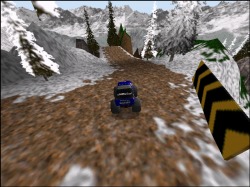 The last example from Bobsled Rally Way is quite the opposite of the thread the needle technique. In this spot, the roadway gives every indication of continuing straght but actually curves to the left up at the end. In order to prevent racers, who might be caught up in the heat of a race, from allowing their momentum to carry them straight and therefore up and out of the race, Spider plants two large trees smack dab in what appears to be the middle of the road.  Racers may not recognize immediately which way the road veers off, but they can be confident that it does not continue onward. Knowing where NOT to go is sometimes as important as the correct direction. SnowboundSkyman uses the same barricade idea in Snowbound. 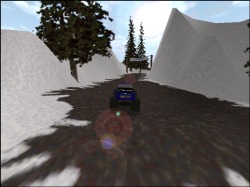 He also threads the needle when he needs to. 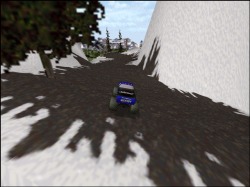 Viewing distance and momentum can conspire against a racer. At this spot, the road travels downhill, allowing a racer to gain considerable speed. The road is straight and sits in a hollow. Just ahead is a river/water fall which is also straight and sits in a v-shape in the terrain. We have our doubts about continuing through a river, but stranger things have been known in custom tracks. The atmosphere is one of speed. And, the combined effect of road, terrain and momentum lulls us into a false sense of security. We push forward at full throttle.  Or rather, we go full throttle until we reach the bend in the road, at which point the brakes come on hard... often to no avail.  Many a racer has washed their tires in that pond, and several have undoubtedly tasted the snow upside the opposite hill. A similar situation, but one that's handled adeptly, happens here. In this case, the road is a lengthy straight-a-way with a tunnel-like feel (mountains on the left, tall trees on the right). The two trees in the distance create the illusion of a threaded needle passage, and so the racer feels confident in their high speed approach. 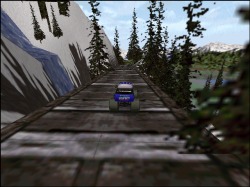 But that's as far as this decoy goes. The tree-line barricade quickly comes into view, thus preventing or at least discouraging an over-shoot at the curve ahead. 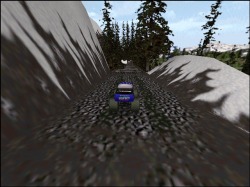 Now, of course, you object: this is all well and good, but I'm not making a mountainous track with snow and pine trees; using these ideas will appear gimmicky in my track. And you'd be right. But remember, Bobsled Rally Way and Snowbound were chosen because they exemplify the topic at hand. How you provide visual cues is entirely up to you, and the context within which you're working. But the principles are the same regardless of the specific track environment. Namely, to include aids that point the way for racers in hard to navigate areas of your track. Lakebed ExtremeIn this example, we drive along the dock of what used to be a lake. The end-of-road barricade works the same here as it does above, with the added bonus that the boat tilted on its side is also pointing in the direction in which you must turn. Despite the lack of actual road and direction signs, there should be little doubt about where you must go next.  Checkpoints do not occur in nature. They are a circuit and rally necessity. And that's fine as far as it goes, but when they are situated in the middle of a non-descript plain they don't lend themselves well as directional indicators. To compensate, Valvejob hems in the checkpoint with barricades and gives them a slight curve to set you in the right direction. 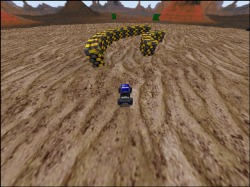 It's true, that you must learn the track to know you must head for the ramp back onto the road way after this checkpoint, but without the curve, this spot loses it's recognizability and distinction from other checkpoints in the same track. The visual dimension makes the difference between finishing a quick and successful lap, on the one hand, or getting totally lost, on the other. Visual cues needn't be restricted to models only. Textures can play a large role in pointing out the course, even when there are no roads. At this junction, the textures and shape of the terrain suggest we're going left. To go in any other direction is to head out into nothingness.  Lastly, models and textures can be combined for better effect. In this spot, the parked train tells us we won't be continuing straight along the tracks, and the blu-ish textures point out the course on the right. 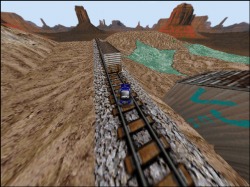 It is not always possible to use 'natural' visual cues. In those cases, we use direction signs. Racing with the finder and map are okay for a lap or two, but sooner or later your track should be able to point the way on its own. Whether you use models or textures to point the way, and whether you make it look natural or man-made will depend on your situation, and is up to you. But the difference between a challenging course or a frustrating experience is not nearly so subjective. Forcing racers to learn of the dangers of a certain route, or even the route itself, only after they're out of the race is the fastest way I know to get your pod deleted permanently from somebody's hard drive. Finding the course should not be the challenge; racing it should be. |